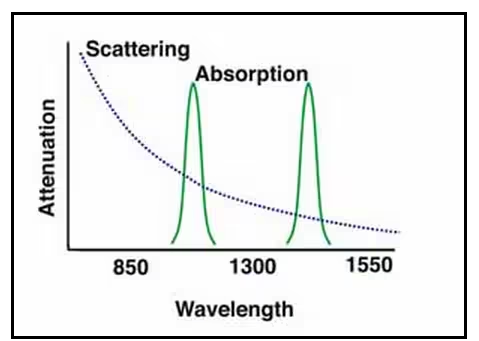

 Knowledge Base +
Knowledge Base +  2024.01.05
2024.01.05The difference between 1310nm and 1550nm lies in their wavelength. 1310nm and 1550nm refer to the wavelengths of light used in optical communication systems.
1310nm is commonly used for short to medium reach communication, such as within a building or a local area network. It is also used in passive optical networks (PONs) for fiber to the home (FTTH) applications.
1550nm, on the other hand, is used for long-haul communication, such as in long-distance telecommunications and undersea cables. It is also less prone to attenuation in fiber optic cables, making it suitable for longer distances.
In summary, the difference between 1310nm and 1550nm is their application in optical communication systems, where 1310nm is suitable for shorter distances and 1550nm is suitable for longer distances.
In selecting the transmission wavelength, the main combined consideration is fiber loss and scattering. The goal is to transmit the most data by transmitting to the farthest distance with the least fiber loss. The loss of signal strength in transmission is attenuation. The degree of attenuation is related to the length of the waveform; the longer the waveform, the less the attenuation. The light used in fiber optics has longer wavelengths at 850, 1310, and 1550 nm, so the attenuation of the fiber is less, which results in less fiber loss. These three wavelengths have almost zero absorption, making them the most suitable for use as a usable light source for transmission in optical fibers.

In fiber optic communications, there are single-mode and multi-mode optical fibers. 850 nm is usually used for multi-mode fiber optic communications, 1550 nm is single-mode, and 1310 nm has both single-mode and multi-mode. Referring to ITU-T, the attenuation of 1310nm is recommended to be ≤0.4dB/km, the attenuation of 1550nm is ≤0.3dB/km. 850nm loss is 2.5dB/km. Fiber optic loss generally decreases with wavelength lengthening, and the central wavelength of 1550 nm around the C-band (1525-1565 nm) is often referred to as the zero loss window, which means that the quartz fiber has a zero loss at this wavelength. quartz fibers have minimal attenuation at this wavelength.
Subscribe to the newsletter
for all the latest updates.
2-5# Building, Tongfuyu Industrial Zone, Aiqun Road, Shiyan Street, Baoan District, Shenzhen. China
